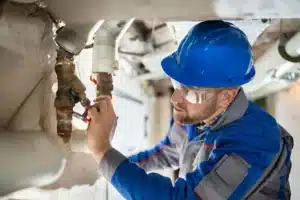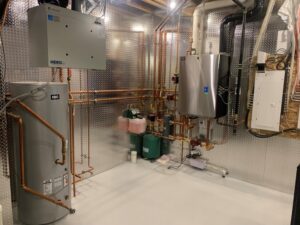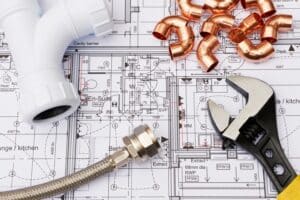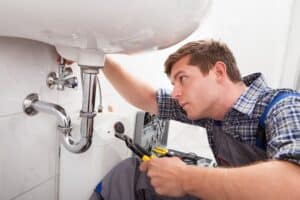Polybutylene plumbing, also known as Poly B plumbing, is a piping material commonly used in residential buildings roughly between 1985 and 1997. At the time, the construction industry considered Poly B plumbing a new and revolutionary way to install new plumbing in your home.
The piping material is grey and very flexible. Contractors frequently used it because of its low cost and easy installation process. Because of this boom in the seemingly ideal plumbing system, hundreds of thousands of Canadian homes have Poly-B of plumbing installed in it.
Unfortunately, Poly B plumbing proved to be problematic. Numerous problems arose from the product, and it is no longer used.
Table of Contents
ToggleProblems with Poly-B plumbing
The main issue with Poly-B pipes was that the pipes cracked easily, causing constant leaks and thus water damage for home and building owners. In addition, because of the low production cost of Poly B pipe, the lower quality shortened the lifespan of the pipes, leading to many homeowners having problems with their home’s plumbing system. However, the inferior make of the pipes wasn’t the only issue. Here are other problems Poly-B pipes can cause in your home:
Bent pipes
Due to the flexibility of Poly-B pipes, installers sometimes took less care putting them in. It was assumed the pipes could bend around nooks and corners without issue. Not only did these assumptions cause problems with water pressure, but it makes it easier for the pipes to crack because of the strain of constant bending. Bending the Poly B plumbing puts a ton of stress on your home’s plumbing system and can potentially lead to expensive damage.
Water pressure
Poly B pipe isn’t able to withstand significant amounts of water pressure. As soon as they do, they are prone to buckling, cracking, or simply providing lousy water pressure. It is a danger to pipes, and it’s also a nuisance to those using any water source in the home.
Bursting pipes
Since the pipes are more likely to fracture and crack, your home could experience burst pipes. A burst pipe means serious water damage throughout your home. Particularly in the winter season, the water can freeze and lead to cracking in your home’s foundation, as well as mold and rotting wood.
Exposure to ultraviolet light
Another damaging feature to Poly B pipe is ultraviolet light. Caused by sunlight, ultraviolet light has been found to damage these pipes, wearing them down, and making them more prone to cracks and holes. Poly-B pipes connected outside the house to the meter will suffer from UV exposure and damage.
Exposure to chlorine
Your home’s water contains some degree of chlorine. Polybutylene plumbing reacts poorly with chlorine. The chlorine can build up over time in the lines and cause cracks in the material. It’ll wear down your pipes, leading to water damage.
Hard to tell
Lots of the problems that can arise from the previously mentioned chlorine issue happen inside the pipes. So, just looking at the exterior of the pipes might not be enough to pinpoint any problem areas that might be experiencing cracking or damage.
No insurance coverage
Because of the discontinuation and lawsuits associated with Poly B pipe, many insurance companies won’t cover the cost of damages that occur from them. Because the plumbing is well-known to cause problems and extensive water damage, insurance companies won’t offer coverage for the buildings that contain them.
How to check if your home has Poly-B pipes
If your home is a newer build, your home probably won’t have Poly B pipes because it was discontinued years ago. However, if you’ve been having problems with your plumbing system and are in an older home, it may be worth checking yourself to see if you’re dealing with Poly B pipe. Then you can advise plumbers of the problem and look for a plumbing company specializing in replacing Poly B plumbing.
You may not want to rip out all your drywall to check if you have these problematic pipes. However, it doesn’t have to come to that, as there are other ways to check. One way is to remove some ceiling tiles from your basement ceiling to see the exposed pipes. Another way is to check your water meter or the pipes connected to your hot water tank.
The pipes will be white or grey. They are also likely to have copper connections attached. If you notice these features, your home likely has Poly-B pipes.
Once you know that you have Poly B plumbing, the next step is to look at replacement costs.
The cost of replacing Poly-B pipes
Depending on how much of your home has Poly B pipe installed in it, the cost may vary. Many factors contribute to the price of reinstalling new plumbing in your home, not just the pipes themselves.
First, you must consider the costs of materials and labour. These costs will depend on the company you choose to use. Search for a plumbing company that has experience replacing Poly-B plumbing. They will be able to identify, remove, and replace your plumbing effectively and efficiently.
There’s also the consideration of how much Poly B plumbing is in your home, whether it be one bathroom, sink, or several around your home. Further investigation may make it necessary for a plumber to open up more drywall than if it’s in a single room.
The overall cost for everything ranges, depending on the above factors. Your quote will factor in the access points to the pipes, the pipes themselves, prices of replacement products, and cost of labour. Replacing Poly-B plumbing could cost anywhere from $10,000 to $20,000.
Selling a home with Poly-B plumbing
Things get more complicated if you realize your home has Poly B pipes before trying to sell your home. While it may seem like less of a headache to let the next owners deal with the plumbing, that may not be the best course of action.
Due to all the issues that come with Poly B pipe, it’s an additional renovation cost that potential home buyers will have to consider when purchasing your home. Unfortunately, you may not get your desired asking amount for your home because of these extra costs. Homebuyers might include replacing the plumbing in their conditions or just deciding on another house altogether.
When selling your home, it’s essential to disclose that your home has a Poly B plumbing system. Just because you may not have experienced any plumbing problems while living there doesn’t mean that the next people living in your home are all set for the future. It could cause issues when it comes up in the home inspection.
If you’re worried about getting the price you want for your home, it may be worth re-plumbing your home and replacing the Poly-B pipes. While it may be a costly job, it could help you sell your home at a higher price. In addition, you don’t want to deter buyers now or in the future. Advertising a brand new plumbing system may also appeal to buyers, letting them know they’ll have less work to do on the home.
Buying a home with Poly-B plumbing
Poly B pipes have an average lifespan of about 10 to 15 years, meaning that nowadays, they’re well past their prime. However, if you’re buying a home that’s known to have Poly B pipe in it, there are a few ways to approach it.
The first way is to negotiate a lower price with the current homeowner because, as previously mentioned, repiping a house isn’t cheap. You may also be able to make a deal with them to split the cost between the two parties. Either way, you need to take care of the situation before you move into the home.
The second way is to have a plumber look at the pipes. If the pipes aren’t in terrible shape, it may not be an immediate danger you’ll have to worry about fronting the cost right now. A plumber will also provide you with the potential cost of replacing the pipes. Depending on how much of the Poly-B pipes are in the home, it might not be as high of a cost as you think.
Buying a house with Poly-B pipes can be a risky deal. However, if you go into the purchase well aware of what you’re getting into and make a plan, you can still get the house you want.
Choosing a plumber for replacing your Poly-B plumbing
When choosing a plumber to replace your Poly-B pipes, there are a few things to watch out for:
Experience with Poly-B pipe
Look for a plumber that has experience with removing Ploy B plumbing. Not only will they be able to remove the pipes carefully, but they’ll know where to look for more suspect pipes.
Get multiple quotes
Don’t just jump on the first plumber you come across. Depending on the size of the job, it’s a good idea to get multiple quotes. Ask lots of questions about your estimate and get as many details as possible. Remember, the cheapest quote is not necessarily the best one.
Get an inspection
Getting an inspection will give you an accurate idea of what you’re looking at in terms of project size. It’ll allow a plumber to provide you with more accurate numbers in terms of prices and timeframes. They’ll also be able to tell you how urgent the project is and whether or not you should replace your Poly B pipes right away.
Options for pipe replacements
Your plumber will help you decide what material you’ll use for your replacement plumbing. Depending on the size of your project and the budget you have available to replace the plumbing, you’ll want to consider your options. For example, many homeowners who are replacing their Poly B pipe turn to copper or PEX pipes. Each comes with unique benefits and is much more reliable than the Poly B plumbing systems.
Copper pipes
Copper pipes have a much longer lifespan. They resist rust and corrosion caused by consistent usage, chlorine in the water, or weather damage. In addition, copper is a very durable material. Copper can be shaped to fit your home correctly and can last up to 70 years.
Copper plumbing can withstand the summer heat and the winter freeze. One thing to consider is the cost of installing copper pipes. It may be a more expensive alternative, depending on the size of your project. It may be more budget-friendly to use copper pipes for smaller jobs, or if the Poly-B pipes are only in a couple of bathrooms.
PEX pipes
PEX pipes are growing in popularity because they come with many benefits that you wouldn’t usually have with Poly B pipes. For instance, PEX pipes are very lightweight, similar to Poly-B. But, they differ in that PEX is built to be flexible to allow for the proper expansion. That way, in colder temperatures, you won’t have to worry about pipes cracking.
PEX plumbing is easy to install, as it doesn’t require specialized fixtures that come with copper pipes. They also don’t develop cracks and holes, are long-lasting, conserve energy, and are cost-effective. PEX might be the way to go if you discovered that most of your home has Poly-B installed.
In conclusion
While Polybutylene plumbing in Canada may have been the big thing decades ago, it’s time for a change. They come with numerous problems, are easily damaged, and have been the subject of multiple insurance debates and lawsuits as a result.
Copper and PEX pipes are great alternatives to Poly-B. These options will last you a long time, and you won’t have to worry about any problems arising. If it is time to replace your Poly B pipe, keep your home safe from any future plumbing issues. Find a reputable plumber in your city today.









